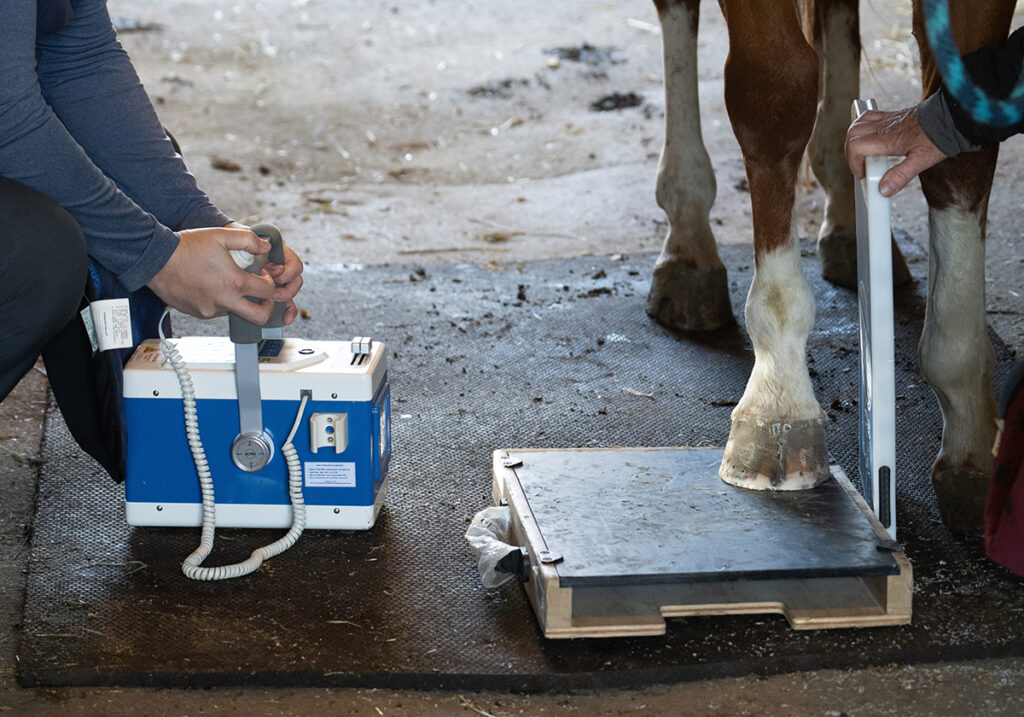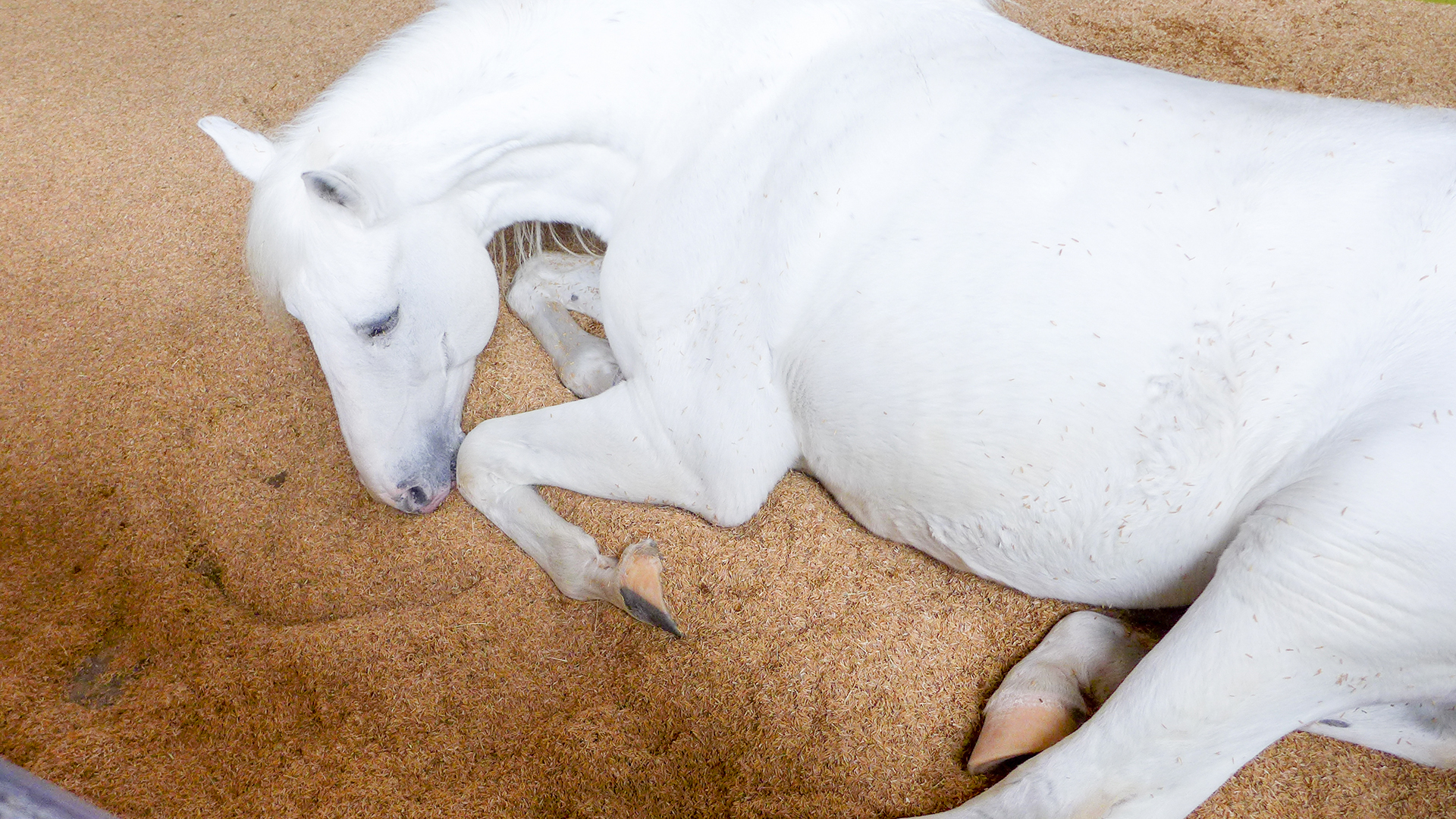Sedation is a common procedure in the equine world and as vets, we would be lost without having safe, reliable and easily administered drugs to use. We use sedation to quiet the horse, which allows us to perform a huge variety of procedures, reducing the risk to horse and human and allowing minimal interference so a procedure can be performed quickly and efficiently.

Sedatives are often used for x-rays where it’s important the horse remains very still.
Sedation may also be required for non-veterinary reasons, including reducing problematic behaviours, increasing compliance during athletic activities and reducing stress during long-term confinement.
SEDATIVES VS TRANQUILLIZERS
Note that there is a difference between a sedative and a tranquillizer, even though they are commonly spoken of as the same product. A tranquillizer is a medication that “brings about a state of peace of mind or relief from anxiety” (Blakiston’s Pocket Medical Dictionary) and does not affect the consciousness of the horse. A sedative, which can also be used to calm a horse, reduces its functional activity and incites drowsiness, from a very mild, almost undetectable level to a profound, almost dysfunctional state, depending on the dose.
As vets, we generally look for sedatives that last from minutes to hours and allow us to perform procedures that may be uncomfortable or painful for the horse. There are hundreds of examples of cases where I need to sedate a horse: X-ray or ultrasound because I need the horse to stand still; passing a stomach tube; or suturing a hind leg where I needed the horse to be drowsy.
Acepromazine (ACP or Ace) is best described as a tranquillizer as opposed to a sedative and is very commonly used in the equine industry. It needs to be given when the horse is quiet and then given sufficient time for it to take effect. ACP is commonly used by laypeople; they can administer the drug and then leave the horse for 10 to 30 minutes before performing an unpleasant procedure or using the horse for an activity for which it needs to remain calm.
I use this tranquillizer very commonly as a pre-anaesthetic medication. I seldom use it as a stand-alone tranquillizer because I rarely have the time to allow it to take full effect, and on most occasions when I need to use sedation, the horse is already stirred up and therefore ACP is less effective. The reason for this is that ACP works by blocking the brain transmitters from attaching to the target sites they need to lodge to cause excitement. If the horse is already excited, the excitation chemicals have had time to attach to their target sites, so the ACP has no effect. A simple analogy: if you want to stop a horse from getting into a yard, you close the gate beforehand, as once the horse has gotten into the yard, closing the gate has no effect.

ACP needs to be used ‘before the horse has bolted’.
ACP can be used in conjunction with either xylazine or detomidine to provide an extended time of tranquillization. This mix can also be used when the horse is already excited. Veterinary advice must be sought before treating sexually mature colts and stallions with ACP; adverse effects, particularly penile prolapse, can occur if given when the colt or stallion is sexually aroused.
Sedatives and tranquillizers should not be given to horses other than the ones that the drug has been prescribed for. These medications can affect blood pressure, and in some cases cause cardiac arrhythmias. They can also cause adverse responses when administered to horses with elevated temperatures, so consultation with your veterinarian prior to use is always recommended.
LONG-TERM OPTIONS
Long-term sedation may be required for a variety of scenarios and requires medication that can be given either less frequently or orally, so the horse is not subjected to daily injections or worse, multiple times during the day to sustain a level of mental drowsiness. This may sound extreme, but it is sometimes necessary to help a horse tolerate extended times in a box, reduce problematic behaviour or training anxiety, or to make aggressive horses easier to handle (although of course this isn’t a substitute for good long term training).
One medication that has been around for decades and used for long term sedation is reserpine, better known as Rakelin. Reserpine is a naturally-occurring substance and the use of plants containing reserpine has been reported in traditional herbal medications for centuries. However, its use in humans and horses as a specific chemical agent has been around for less than 80 years.
This drug leads to degradation of norepinephrine, dopamine and serotonin. Without these neurotransmitters, the horse cannot get overexcited, which could be more aptly described as becoming depressed.
Reserpine can be given via intramuscular (IM) injection (trademark Rakelin) or orally. The results can vary, and for this reason many people believe that the medication doesn’t work, but the perceived ineffectiveness can be due to inappropriate use. Horses respond differently to reserpine, so IM dosing is required until the neurotransmitters are depleted, and then the horse can be maintained on a 7 to 10-day IM dose. For some horses this depletion occurs after a single injectable dose; for other horses three or more doses, given within days of each other, are required. Adequate dosing is usually seen with the horse showing mild diarrhoea or penile prolapse. Oral dosing of reserpine is generally administered daily, with the amount given dictated by the horse’s response.
While it is classified as a long-term tranquillizer, in my experience reserpine does produce a degree of drowsiness as well as reducing the anxiety levels in a horse. Some equine welfare groups have questioned whether the use of this drug is ethical, and it has also been classified as a banned substance by the FEI.
Unfortunately, stereotypical behaviours such as windsucking (cribbing), weaving, stall walking and kicking walls are common, and once a horse is afflicted, they can be difficult to manage. These behaviours are blamed on multiple causes, including gastric ulcers, boredom, isolation and horses learning from other horses. Sedation cannot be used to cure these horses, or even reduce the intensity of the behaviour, but sedation and anti-anxiety medication can be administered for short-term relief when the horse needs to be boxed for short periods, is unduly restless in a particular environment, or is overly stimulated.
For longer-term treatment, the use of behavioural modifiers is more appropriate than continual administration of sedatives. These include some of the medications used as anti-depressants in humans that are marketed to reduce anxiety. When used in minute amounts, the sedative effect is virtually undetectable and behaviour is modified, but as doses increase, the degree of sedation also increases.
Serotonin is a chemical produced in the brain and in the gastrointestinal tract that allows messages to be transmitted from nerve cell to nerve cell. Serotonin plays a significant role in gut function and digestion but is also responsible for behavioural practices that affect mood and sleep. When levels of serotonin are low, a horse can show mood depression and poor behaviour. Some studies support the use of medications that increase the serotonin levels in a horse’s brain, but the results are based on subjective assessment and not quantifiable analysis. Up to 70 percent of owners have reported their horses display reduced stereotypical behaviour when administered behavioural modifiers. These medications are also used when horses need to be restricted to a box for periods that are too long for a horse to be continually sedated. Trazadone and Fluoxetine (sold as Prozac to humans) are two such medications. These are from a family of medications referred to as Selective Serotonin Reuptake Inhibitors and work by preventing the uptake of serotonin and therefore the breakdown of the chemical, allowing serotonin to persist in the brain for longer. Fluoxetine might be the better of the two to use, as Trazadone is thought to have more side-effects.

Tine Magnus’ horse Dia van het Lichterveld Z tested positive to Trazadone at the Paris Olympics, resulting in the Belgian team’s disqualification from the Games. Image by FEI/Benjamin Clark.
Sedation during competition is used occasionally (illegally), but far less frequently than in years gone by, due to the scientific advancements made with drug detection. The most common reason for sedation is to reduce anxiety and improve behaviour so the horse performs to the best of its ability. For this reason, many of the drugs used can perhaps be better described as behavioural modifiers. In competitions where horses are seldom tested, owners and riders will sometimes use minute quantities of the commonly used sedatives such as ACP and Dormosedan to “take the edge off”. In more tightly regulated equine competitions, more sophisticated medications are being used. These include the above-mentioned Fluoxetine and Trazadone; however, these too are becoming readily detectable, deterring some competitors from using them while forcing others to search deeper to find yet undetectable behaviour modifiers. EQ






